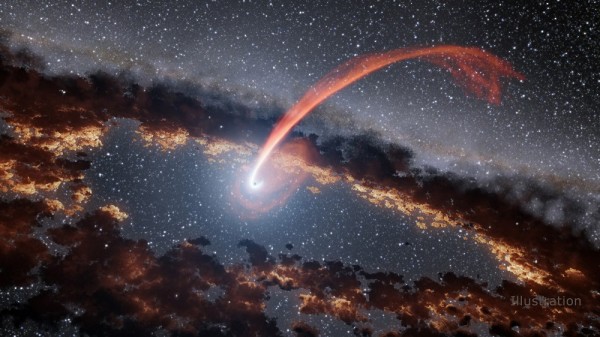By Ana Verayo, | September 19, 2016

This illustration shows a glowing stream of material from a star as it is being devoured by a supermassive black hole in a tidal disruption flare.
Black holes are known to devour virtually anything in their path including cosmic gasses, dust, matter, light, sound, and even stars.
However, for the first time, astronomers have documented a supermassive black hole eating up an entire star via infrared wavelengths. The colossal cosmic monster burped a brilliant flash of light that produced "echoes" across deep space.
Like Us on Facebook
NASA scientists and Chinese researchers call these flashes of light "tidal disruption flares." They were detected with NASA's Wide-field Infrared Survey Explorer (WISE) - a space telescope that can observe the skies with infrared light.
According to the lead author of the NASA study, Sjoert van Velzen of the Johns Hopkins University, this is the first time that infrared light echoes have been seen originating from multiple tidal disruption events. The NASA study involved three black holes swallowing stars. A fourth black hole was detected by Chinese scientists.
This event follows an equally bizarre event called "spaghettification." This occurs when a star gets too close to a black hole. It gets stretched out due to the gravitational forces tearing up the star, elongating everything and warping spacetime altogether.
After feasting on a star, a black hole can "burp" by emitting large amounts of energy such as X-ray light and ultraviolet light that can destroy anything in their path.
When this intense light and radiation streams across the universe, cosmic dust and gasses can filter this light up to three trillion miles away from the black hole. Cosmic dust particles absorb these light remnants and then shine with infrared wavelengths.
Scientists have detected several X-ray emissions from these black holes that are considered to be radiation signatures of this cosmic event.
The WISE space telescope captures these "echoes" emanating from the stellar destruction caused by black holes, and measures delays between the original light flare and the following echoes. Scientists can then estimate how much energy was released before the star was entirely eaten by the black hole.
-
Use of Coronavirus Pandemic Drones Raises Privacy Concerns: Drones Spread Fear, Local Officials Say

-
Coronavirus Hampers The Delivery Of Lockheed Martin F-35 Stealth Fighters For 2020

-
Instagram Speeds Up Plans to Add Account Memorialization Feature Due to COVID-19 Deaths

-
NASA: Perseverance Plans to Bring 'Mars Rock' to Earth in 2031

-
600 Dead And 3,000 In The Hospital as Iranians Believed Drinking High-Concentrations of Alcohol Can Cure The Coronavirus

-
600 Dead And 3,000 In The Hospital as Iranians Believed Drinking High-Concentrations of Alcohol Can Cure The Coronavirus

-
COVID-19: Doctors, Nurses Use Virtual Reality to Learn New Skills in Treating Coronavirus Patients







